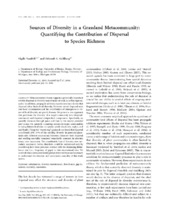Sources of Diversity in a Grassland Metacommunity: Quantifying the Contribution of Dispersal to Species Richness
Peer reviewed, Journal article
Permanent lenke
http://hdl.handle.net/1956/2546Utgivelsesdato
2006Metadata
Vis full innførselSamlinger
Originalversjon
https://doi.org/10.1086/505759Sammendrag
Metacommunity theory suggests a potentially important role for dispersal in diversity maintenance at local, as well as regional, scales. In addition, propagule addition experiments have shown that dispersal often limits local diversity. However, actual dispersal rates into local communities and the contribution of immigrants to observed local diversity are poorly known. We present a new approach that partitions the diversity of a target community into dispersalmaintained and dispersal-independent components. Specifically, we quantify distances through space and time to the nearest potential seed source for naturally occurring recruits in target communities by using hierarchical data on species pools (local, site, region, and seed bank). Using this “recruit tag” approach, we found that dispersal contributed 29%–57% of the seedling diversity in perennial grasslands with different successional histories. However, both dispersal and seedling mortality remained remarkably constant, in absolute terms, over succession. The considerable loss of diversity over secondary succession (66%), therefore, could be understood only by considering how these processes interact with the decreasing disturbance rate (i.e., frequency of gaps) in later-successional sites. We conclude that a metacommunity perspective is relevant and necessary to understand the diversity and community assembly of this study system.
